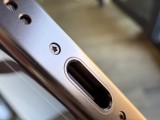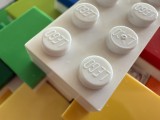Apple iPhone 16 Pro review

Small Pro gets the Max's 5x zoom
The small Pro no longer has to settle for inferior hardware to the Max's - the 16 Pro gets the exact same setup as the 16 Pro Max, including the 5x zoom camera and the new ultrawide. That's in addition to the new Tone setting in the camera app, as well as the obvious Camera Control key, of course.

The new ultrawide for this generation is using a 48MP Quad Bayer type sensor in place of the old 12MP conventional RGB one. Apple isn't specifying the imager size, but napkin math points to 1/2.55" - if the old one was 1/2.55" with a 1.4µm pixel pitch, then the new one with 0.7µm pixels is surely going to be 1/2.55" too.
The main camera uses the same 1/1.28" type sensor as last year - a reasonable size in the global scheme of things and ever so slightly larger (inconsequentially so, but still) than what's found on key competitors like the Pixel 9 Pro. It remains one of the few camera modules in the business with sensor-shift stabilization.
The telephoto is sort of the big upgrade on the 16 Pro - it gets the 5x zoom module of Maxes, in place of the 3x unit of last year's Pro non-Max. It's not a cutting-edge piece of kit - a 1/3.06" 12MP RGB imager doesn't sound remotely impressive in 2024. The tetraprism lens is far from pedestrian though, with Apple's folded design setting it apart from the periscopes of pretty much every other maker.
There don't appear to be any changes in the selfie camera compared to the previous generation.

- Wide (main): 48MP (1/1.28", 1.22µm-2.44µm), f/1.8, 24mm, dual-pixel PDAF, sensor-shift IS; 4K@120
- Ultrawide: 48MP (1/2.55", 0.7µm-1.4µm), f/2.2, 13mm, PDAF; 4K@60fps
- Telephoto 5x: 12MP (1/3.06", 1.12µm), f/2.8, 120mm, dual pixel PDAF, sensor-shift IS; 4K@60fps
- Front camera: 12MP (1/3.6", 1.0µm), f/1.9, 23mm, PDAF; 4K@60fps
Of course, the big news this year is the new Camera Control. The extra hardware button on the right side of the phone offers mechanical pressing with actual key travel, as well as pressure sensing for light(-er) presses and capacitive sensitivity for swiping, all of this enabling a ton of functionality, with more to come with a future update.
What's missing so far is the two-stage shutter release capability, which is going to leverage the pressure sensitivity for the focusing stage, keeping the click for the shutter release. We're still debating whether that's a truly useful piece of innovation in 2024, or a solution in search of a problem.

The already present functionality includes the ability to launch the camera app (from a locked or unlocked state), including third-party camera apps. You even get to choose whether you'd like a single-press or a double-press action for the quick launch - that sure feels like too much customization from an Apple phone.
Once you're in the Camera, a click captures a photo, while holding down the button records a video for as long as you have it depressed.
The other thing you can do with it, is tweak parameters on the fly. The available settings include exposure compensation, simulated aperture, zoom level (stepless), camera switching (just the native focal lengths), photographic styles and 'Tone'. Double 'light press' (before the click) lets you change the parameter to be adjusted, while a single light press subsequently brings back the previously selected parameter. The adjustment itself happens by swiping on the capacitive sensor or on the actual display in the general area of the button's on-screen manifestation.
Overall, we can probably see where Apple is coming from with the Camera control - we just don't feel like it solves a real problem. It's not particularly intuitive, it can be fiddly to use, and it can get in the way in situations when you're not meaning to use it.
We mentioned Tone above, and it's a new angle on the previously present Photographic Styles. This one in particular aims to give you more control over the HDR processing intensity - something that's apparently been causing a stir on the internet.
There are two sets of Photographic styles, labeled Mood and Undertones, and for each style you can tweak the Tone (think of it as contrast or tone curve), Color (saturation), and Palette (sort of like a color filter). The Mood styles have pre-set values for all three parameters (Palette is always at 100), while the Undertone styles only alter Palette by default.
We appreciate the added layer of customizability in the way an iPhone will render the world around it so that you can personalize the photos you get out of your phone to your own taste. We'd almost be inclined to praise Apple for giving you all those options, though we're also of the opinion that the phone that 'just works' maybe shouldn't have to resort to glorified filters to try and please everyone. Or maybe that's too harsh, and Apple's approach is precisely the correct one.
Daylight photo quality
Main camera
As we already observed on the iPhone 16 Pro Max and on other previous instances with Apple phones, the 16 Pro's default output is a bit lacking in immediate appeal, the relatively low saturation and somewhat aggressive HDR making for less overall 'pop'. The rendition does tend to vary between devices, and on the phone itself photos do look a lot more likable.
As mentioned above, you get plenty of control over the look of those images through the Photographic Styles interface, so if the default results aren't your thing - go ahead and find your thing with the Tone and Palette adjustments.
When it comes to detail, you can expect the same results from this iPhone 16 Pro, that you'd get from the other iPhones of the day - another aspect of the consistency in iPhone imagery. Truth be told, that's more or less the same amount of detail you'd get from any current high-end phone, with the differences coming down to the character of the processing - the iPhone's isn't too natural, but it's hardly the worst we've seen either. There's a certain graininess in some areas, but skies remain clear of noise.






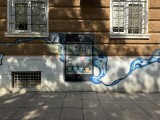


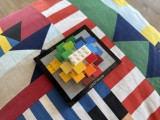

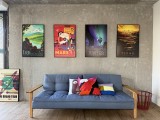
Daylight samples, main camera (1x), 12MP
iPhones stand out from the majority of other phones in that they have a 24MP mode on their main cameras in addition to the more obvious 12MP option. Indeed, the 24MP shots do provide extra detail and definition without any drawbacks in other image parameters.


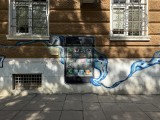


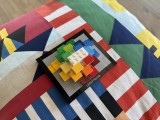

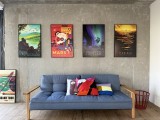
Daylight samples, main camera (1x), 24MP
The full-res 48MP mode may not get you true 48MP worth of detail, but it remains one of the more useful implementations and can potentially extract some extra definition out of a scene, depending on subject matter, light, shooting distance and whatnot.






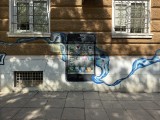


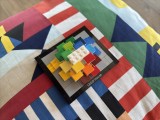
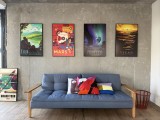
Daylight samples, main camera (1x), 48MP
Within our fairly limited experience with people shots, the iPhone does well, with reasonably lively skin tones. We're still dialing in a few new shooting locations and they're seemingly rather dim, so the phone isn't able to maintain base ISO and absolute sharpness isn't at its full potential.
Portrait mode is fairly reliable too, though not necessarily infallible. Some of the Portrait mode shots are that little bit softer than the regular photos, too.






Daylight samples, main camera (1x), Photo mode






Daylight samples, main camera (1x), Portrait mode
The iPhones have continually impressed us with their 2x results and the 16 Pro is no different. Perhaps the vivo X100s of this world can do a little better still, for those that care, but the iPhone is plenty good enough.






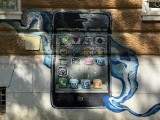




Daylight samples, main camera (2x)
The 48mm equivalent focal length is ideal for people shots, whether in Photo mode or Portrait mode. Again, dimmer ambient conditions don't help, but even then the photos aren't half bad.






Daylight samples, main camera (2x), Photo mode






Daylight samples, main camera (2x), Portrait mode
Telephoto camera
The telephoto camera is a proven performer in daylight and captures excellent 5x zoom shots with great detail. The overall look is expertly matched to the other cameras too.






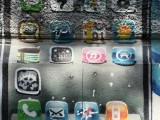




Daylight samples, telephoto camera (5x)
The 120mm focal length of the telephoto camera is great for tightly framed portraits or shooting from afar.






Daylight samples, telephoto camera (5x), Photo mode






Daylight samples, telephoto camera (5x), Portrait mode
At 10x, the level of detail that the 16 Pro captures is okay - things are not as clear as what the Pixel 9 Pro or the Galaxy S24 Ultra can muster at 10x, but the detail is about on par.
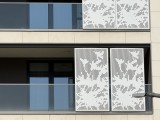



Daylight samples, telephoto camera (10x)
Ultrawide camera
The ultrawide camera is similar in its rendition to the main camera too, with a bit of extra grit which is perhaps a little too much. Colors are once again not too lively, but the Photographic styles are there for you.









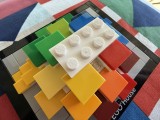


Daylight samples, ultrawide camera (0.5x)
The ultrawide's full-res mode isn't quite as useful as on the main camera, though there might be the occasional scene where you'd be able to extract an extra bit of detail.








Daylight samples, ultrawide camera (0.5x), 48MP
Apple's way of enabling close-up shooting relies on the ultrawide camera and while it's not as nice as a proper close-focusing telephoto, the 'macro mode' shots are still pretty solid.
Selfies
Selfies are pretty great on the iPhone 16 Pro, as expected from an iPhone. We're getting very good detail, nicely tailored exposures, and the ability to focus close allows for some weird angles too.
Low-light photo quality
Low-light photography on iPhone is realized in such a way that it doesn't really let you force a Night mode on a scene so it's up to the phone to decide when to engage it. That doesn't happen very often on the main camera - only in particularly dark or contrasty scenes. The ultrawide seems to resort to it a bit more regularly, while the telephoto is somewhere in the middle.
That said, 'Night mode' as a concept has been gradually stripped of meaning, with layers of under-the-hood processing happening without much of an indication on the user's end. What you can do is disable it, though we're not exactly sure why anyone would do such a thing.
Main camera
Low-light photos from the iPhone 16 Pro's main camera are excellent, whether there's explicit Night mode action or not. Exposures are well balanced, with a tendency to prioritize highlight retention, but somehow also do a measured shadow boost. There's an ongoing discussion about that brightly-lit sign in the third sample, with opinions ranging from the usual 'the iPhone's rendition is nice and realistic' to 'that's way too burnt out' but outside of such specific cases, things are generally universally liked.
Detail can have some of that extra bit of grit, but it's not an offensive look, and we do enjoy the level of definition that remains alongside it. We have no complaints about the auto white balance or the color saturation levels at night.





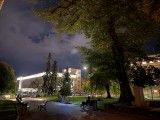
Low-light samples, main camera (1x)
You can also count on the 2x zoom level to deliver good images at night, without a significant drop in quality compared to both the daytime results or the 1x low-light shots.






Low-light samples, main camera (2x)
Telephoto camera
The telephoto camera's low-light results are very good, without being truly exciting. We can appreciate what Apple has done with what's a relatively small sensor and not too bright of a lens, it's just that they could have done better with better hardware. Once again, there's a fair bit of noise to go with what we'd call good detail levels. The dynamic range and color rendition are very good too.



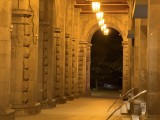


Low-light samples, telephoto camera (5x)
Ultrawide camera
The ultrawide may be resorting to Night mode more often, but whether with or without it, it's not producing impressive results. Detail is on the soft side when examined from up close, so perhaps stick to more modest magnifications. More difficult scenes (darker, or higher contrast ones) can end up underexposed and rather gloomy, though at least the highlights are generally very well preserved.
White balance remains accurate, even in mixed lighting.






Low-light samples, ultrawide camera (0.5x)
Video recording
The iPhone 16 Pro Max can record video up to 4K60 with all of its cameras (the three rear ones, and the front-facing one), and 30fps and 24fps modes are also available across the board. The primary camera on the back can also do 4K120, at both 1x and 2x zoom. Also available, at least on our Euro units, are PAL modes (25fps and 100fps). If you want to capture 4K60 or higher, you must do so in the 'high-efficiency' HEVC/h.265 format, while for lesser modes you can choose between that and the AVC/h.264 option. Dolby Vision recording is also on the menu.
There are two audio tracks recorded - stereo AAC and four-channel APAC - that is, if you've enabled Spatial Audio in settings. You can set it to simple stereo, or mono.
Stabilization is always on in all modes (including 4K120) - you can't turn it off if you have other means of ensuring stable footage.
Video sample playlist
You can check out the playlist below, which includes multiple video samples.
Videos captured on the iPhone 16 Pro in broad daylight are excellent on the rear cameras, including the main-camera sourced 2x zoom level. There's very good detail, rendered in a measured way, and noise is not a thing in the footage. The auto white balance may have rendered our balcony scene with a hint of added warmth, though that's not really hurting anyone, and the saturation level is very appealing. Dynamic range is also very good.
It's worth mentioning that there is no difference in quality between frame rates - 24fps, 30fps, and 60fps clips from each camera all look the same. Not that we'd expect anything from an iPhone, but we'd be there to call them out on it if they drop the ball.
Stabilization is excellent as always - on all cameras, in all modes.
In low light, you'll easily be able to spot the bright internal reflections from point light sources in main camera footage - iPhones have been particularly prone to that over the years, and the 2024 generation isn't the one to fix it. It's not nearly as bad as to render the videos useless, but it can be annoying depending on the scene.
Anything but useless, in fact - the 16 Pro's main camera low-light clips are among the best in the industry, even with that flaw accounted for. The 2x zoom level videos hold up well, too. The telephoto doesn't deliver a standout performance compared to its peers, but it's no worse either. The ultrawide, on the other hand, is softer than on key rivals, but it's not like key rivals can offer truly good ultrawide footage either.
Reader comments
- Coolio
- 10 Apr 2025
- 3yN
So you put your money in the bin then?
- Mateus
- 04 Apr 2025
- J4x
Just bought mine today, goodbye Android and Google, I'll never put my money again on cheap devices/experiences.
- Anonymous
- 22 Mar 2025
- n5A
I could've sworn when this was first reviewed it got 4.6. I went on wayback machine to check and I was right. The original score WAS 4.6. So, GSMA knocked a point off for some reason?






